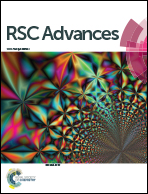Synthesis of a new 18F labeled porphyrin for potential application in positron emission tomography. In vivo imaging and cellular uptake
Abstract
Herein we report, for the first time, the development, labeling optimization and preliminary biodistribution studies of an [18F] radiolabeled meso-tetraphenylporphyrin. After synthesis and characterization of the “cold” fluorinated porphyrin, the conditions have been transferred to an automated radiochemistry module and the desired 5-(2-[18F]fluoroethoxyphenyl)-10,15,20-triphenylporphyrin was prepared in a radiochemical purity >95%. Moreover, data regarding the uptake into human bladder tumor cells and the radiotracer biodistribution after C57BL/6 mice injection are also presented. The maximum cellular uptake was reached at 45 min and was of 2.5%.



 Please wait while we load your content...
Please wait while we load your content...